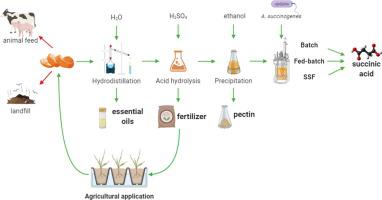Waste Management ( IF 7.1 ) Pub Date : 2020-06-27 , DOI: 10.1016/j.wasman.2020.06.020 Maria Patsalou 1 , Antonios Chrysargyris 2 , Nikolaos Tzortzakis 2 , Michalis Koutinas 1

|
A process for the valorization of citrus peel waste (CPW) has been developed aiming to produce succinic acid and a series of added-value products through the biorefinery platform. CPW was subject to physicochemical and biological treatment to isolate essential oils (0.43%) and pectin (30.53%) as extractable products, pretreating the material for subsequent production of succinic acid that enabled application of remaining biorefinery residues (BR) as fertilizer substitute. Cellulose, hemicellulose and lignin contents of CPW accounted for 22.45%, 8.05% and 0.66% respectively, while acid hydrolysis reduced hemicellulose by 3.42% in BR. Moreover, essential oils extracted from CPW included 17 compounds, among which D-limonene reached 96.7%. The hydrolyzate generated was fermented for succinic acid production using Actinobacillus succinogenes. Different batch experiments demonstrated that the combined use of corn steep liquor (CSL) and vitamins in a lab-scale bioreactor resulted in product concentration and yield that reached 18.5 g L−1 and 0.62 g g−1 respectively. Although simultaneous saccharification and fermentation (SSF) could not enhance succinic acid production, a fed-batch fermentation strategy increased succinic acid concentration and yield generating 22.4 g L−1 and 0.73 g g−1 respectively, while the mass of the platform chemical formed was enhanced by 27% as compared to the batch process. BR was explored as fertilizer substitute aiming to close the loop in the management of CPW towards development of a zero-waste process demonstrating that although the material imposed stress on plant growth, the content of potassium, phosphorus and nitrogen in the mixture increased.
中文翻译:

通过不同的发酵策略将柑桔皮废物转化为精油,果胶,肥料和琥珀酸的生物精炼厂。
为了通过生物精炼平台生产琥珀酸和一系列增值产品,已经开发了一种柑橘皮废料(CPW)的增值方法。CPW进行了物理化学和生物处理,以分离出可提取产品的香精油(0.43%)和果胶(30.53%),对原料进行预处理,以用于随后的琥珀酸生产,从而使剩余的生物精炼残余物(BR)可以用作肥料替代品。CPW的纤维素,半纤维素和木质素含量分别占22.45%,8.05%和0.66%,而酸水解使BR中的半纤维素减少3.42%。此外,从CPW中提取的精油中包含17种化合物,其中D-柠檬烯达到96.7%。发酵产生的水解产物用于发酵生产琥珀酸,方法是使用放线杆菌琥珀酸。不同的分批实验表明,在实验室规模的生物反应器中玉米浸渍液(CSL)和维生素的组合使用可导致产品浓度和产量分别达到18.5 g L -1和0.62 g g -1。尽管同时进行的糖化和发酵(SSF)不能提高琥珀酸的产量,但分批补料发酵策略可以提高琥珀酸的浓度并提高产量,分别产生22.4 g L -1和0.73 g g -1分别,而形成的平台化学品的质量与批处理过程相比增加了27%。BR被用作肥料替代品,旨在封闭CPW的管理流程,实现零废物生产,这表明尽管该材料对植物生长造成了压力,但混合物中钾,磷和氮的含量却有所增加。











































 京公网安备 11010802027423号
京公网安备 11010802027423号